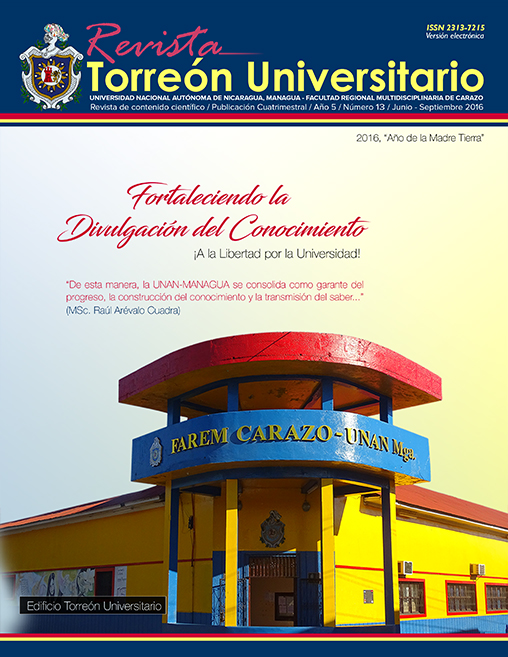Contribución de las TIC en el aprendizaje integral del inglés, en los estudiantes de Inglés de la UNAN-Managua
Resumen
Con el objetivo de analizar la contribución de los medios tecnológicos, TIC, en el aprendizaje integral del inglés, en los estudiantes de la carrera Licenciatura en Ciencias de la Educación, de la UNAN-Managua, se realizó un estudio descriptivo, correlacional y analítico que se llevó a cabo con un grupo de siete docentes y un universo de 360 estudiantes de la UNAN-Managua. A partir de los datos recolectados (partiendo de una muestra de 190 estudiantes), se diseñó la base datos correspondiente. Una vez que se realizó el control de calidad de los datos registrados, se realizaron los análisis estadísticos pertinentes.
De acuerdo a las variables (cuantitativas o cualitativas) y guiados por el compromiso definido en cada uno de los objetivos específicos, se realizaron los análisis descriptivos correspondientes a las variables nominales y numéricas, entre ellos: (a) El análisis de frecuencia, (b) las estadísticas descriptivas según cada caso. Además, se realizaron gráficos del tipo: (a) barras de manera univariadas para variables de categorías en un mismo plano cartesiano, (b) barras de manera univariadas para variables dicotómicas, que permitan describir la respuesta de múltiples factores en un mismo plano cartesiano.
Del análisis y discusión de los resultados obtenidos, se alcanzaron las siguientes conclusiones: El sexo femenino fue el de mayor predominio con un 57.22 %; las edades más frecuentes estuvieron entre los 18 y 23 años. Los medios tecnológicos de mayor uso fueron: la grabadora con un 80 % y el proyector con un 69 %; y los de menor uso fueron la tableta con un 5 % y el televisor con un 9 %. Se realizaron los análisis de contingencia pertinentes (Crosstab análisis), para todas aquellas variables no paramétricas, a las que se les podrá aplicar la prueba de Correlación no Paramétrica de Spearman (Rho de Spearman) y Tau C de Kendall. Estas pruebas se tratan de una variante del coeficiente de correlación de Pearson, los cuales permiten demostrar la correlación lineal entre variables de categorías, mediante la comparación de la probabilidad aleatoria del suceso y el nivel de significancia prestablecido para la prueba entre ambos factores, de manera que cuando p ≤ 0.05 se estará rechazando la hipótesis nula planteada de ρ=0.Descargas
Citas
Alonso Díaz, L. & Blásquez Entonado, F. (2012). El docente de educación virtual. Madrid: Narcea.
Astolfi, J. P. (1997). Aprender en la escuela. Santiago: Dolmen.
Barraza, A. (2013). Presencia discursiva del estrés académico en la blogósfera. Revista Iberoamericana de Psicología: Ciencia y Tecnología, 6(2), 45-54.
Biggs, J. (2008). Calidad del aprendizaje universitario. Madrid: Narcea.
Calvo, C. (2005). Entre la educación corporal caótica y la escolarización corporal ordenada. Obtenido de Revista IberoAmericana : http://rieoei.org/rie39a04.htm
Capacho, J. (2011). Evaluación del aprendizaje en espacios virtuales - TIC. Obtenido de https://books.google.com.ni/books?id=44Q4hgDjilUC&pg=PA55&lpg=PA55&dq=Don+Tapscott+(1998),+tiene+la+posibilidad+de+pasar+%E2%80%9Cdel+aprendizaje+como+tortura+al+aprendizaje+como+diversi%C3%B3n&source=bl&ots=gpflABPf4m&sig=xfWlW2lwhze8XV-s_8jf6ppWN5c&hl=e
Díaz, J. (1994). El currículum de la educación física en la reforma educativa. España: INDE Publicaciones.
Escobar, J. & Bonilla, F. (2014). Grupos focales:Una guía conceptual y metodológica. Obtenido de Cuadernos hispanoamericanos de psicología: http://www.uelbosque.edu.co/sites/default/files/publicaciones/revistas/cuadernos_hispanoamericanos_psicologia/volumen9_numero1/articulo_5.pdf.
Escribano, A. (2004). Aprender a enseñar. Fundamentos de didáctica general. España: Universidad de Castilla La Mancha.
Grados, J. & Sánchez, E. (2007). La entrevista en las organizaciones. Obtenido de Manual moderno: http://biblio3.url.edu.gt/Libros/la_entrevista/4.pdf.
Medina Rivilla, A., Domínquez Garrido, M. C. & Gonçalves, F. R. (2011). Formación del profesorado universitario en las competencias docentes. Historia de la Educación Latinoamericana, 119-138.
Munch Galindo, L. (1996). Métodos y Técnicas de Investigación. Trillas.
Muñoz, P. C. & González, M. (2009). Plataformas de Teleformación y herramientas telemáticas. Barcelona: UOC.
Orozco Silva, C. D. (1996). Pedagogía de la educación sperior y calidad de la docencia. Bogotá: Universidad de los Andes.
Pérez Gómez, Á. & Gimeno Sacristán, J. (1996). Comprender y transformar la enseñanza. Morata.
Revista Latina de Comunicación Social, La Laguna. (2002). Revista Latina de Comunicación Social, La Laguna, 5(50).
Salmerón, M. (2011). Estilos de enseñanza y funciones del profesorado. Obtenido de Lecturas de educación física y Deportes, Revista Digital: http://www.efdeportes.com/efd156/estilos-de-ensenanza-y-funciones-del-profesorado.htm
TICs antecedentes. (2014). Obtenido de: http://www.buenastareas.com/ensayos/Tics-Antecedentes/59541516.html
UNAN & CURC. (2007). Diplomado en educación superior. Jinotepe: UNAN.
UNAN-Managua. (2014). Facultad de educación e Idiomas. Obtenido de http://fei.unan.edu.ni/
UNAN-Managua. (2016). Aulas virtuales. Obtenido de: http://www.unan.edu.ni/avunan/
Zabalza, M. (2004). Innovación de la enseñanza universitaria.
Zabalza, M. Á. (2006). Competencias docentes del profesorado universitario (2da ed.). Madrid, España: Narcea.
Descargas
Publicado
Cómo citar
Número
Sección
Licencia
The authors who publish in this journal agree to the following terms.
- The author or authors of the articles, essays or research grant the National Autonomous University of Nicaragua, Managua (UNAN-Managua) the editing rights (copyright) of the submitted work, therefore the University has the exclusive right to publish the article for the entire copyright period.
- These copyrights/authors authorize Torreón Universitario Magazine and the University to edit and disseminate/publish the article in said Magazine, including printed and electronic reproduction, storage, retrieval and any other type of publication, and sources of secondary information as services. of summaries and databases, they also empower it to protect the article against unauthorized use for dissemination by printed or electronic media (PDF, HTML, EPUB, XML or others).
License for use of content
The magazine uses the Creative Commons Attribution-NonCommercial-NoDerivs 4.0 International License.
Under this statement:

This journal is licensed under a Creative Commons Attribution-NonCommercial-NoDerivatives 4.0 International License. It can be copied, distributed and transmitted publicly as long as the author and source are cited (Revista Torreón Universitario), it should not be modified or used for any commercial purpose. The full license can be found at http://creativecommons.org/licenses/by-nc-nd/4.0/.



